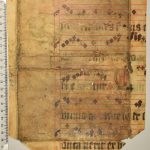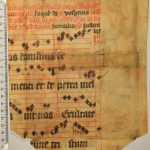In this fragment segments of the Office of Corpus Christi were preserved. On the recto the responsory Ego sum panis vitae with its verse (Ego sum panis vivus) is legible. This responsory was part of the uncommon office Sapientia aedificavit, preserved only in a few sources throughout Europe, among others, in the appendix of the 13th century notated Esztergom Breviary (Praha, Library of the Royal Canonry of Premonstratensians at Strahov, DE I 7. Ed. Janka Szendrei, Beviarium notatum Strigoniense saeculi XIII, Musicalia Danubiana 17, Budapest, HAS, Institute for Musicology, 1998). However, it is not certain, that the original codex, from which this fragment derives, included the entire Sapientia aedificavit cycle, since in some sources its responsories were mixed with the chants of the widespread Sacerdos in aeternum office of Corpus Christi. We assume that the original manuscript contained this latter office, and that the uncommon responsory was placed in it only as a foreign body, presumably in the last nocturn. This theory is supported by the rubric on the verso, which lists the regular antiphons of the Sacerdos in aeternum with their psalms (Introibo, Cibavit, Ex altari tuo). Considering its text (…omnia ut in festo eiusdem) the rubric assigned the chants for the Octave of the feast. For the two Corpus Christi Offices see Anna Sanda, „»Sapientia aedificavit«: Phasen der Entstehung des Offiziums und der Kodifikation eines spätmittelalterlichen Festes, Zenetudományi Dolgozatok 2015 – 2016, In memoriam Kiss Gábor, red. Gabriella Gilányi and Gábor Kiss (Budapest: HAS Research Centre for the Humanities, Institute for Musicology, 2018), 61–85.
Gabriella Gilányi, Zsuzsa Czagány



